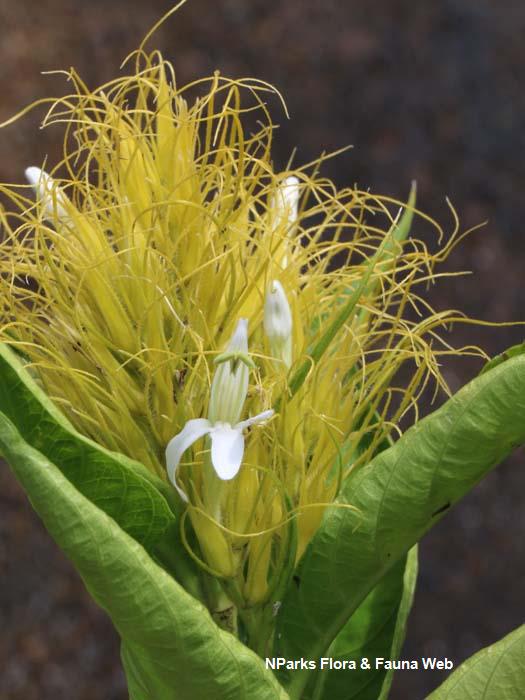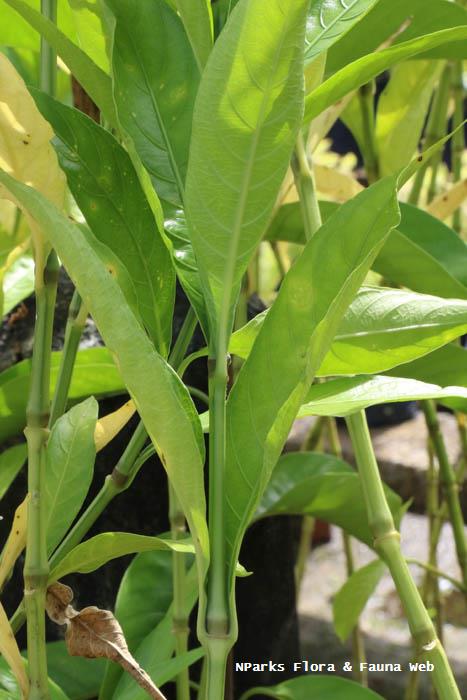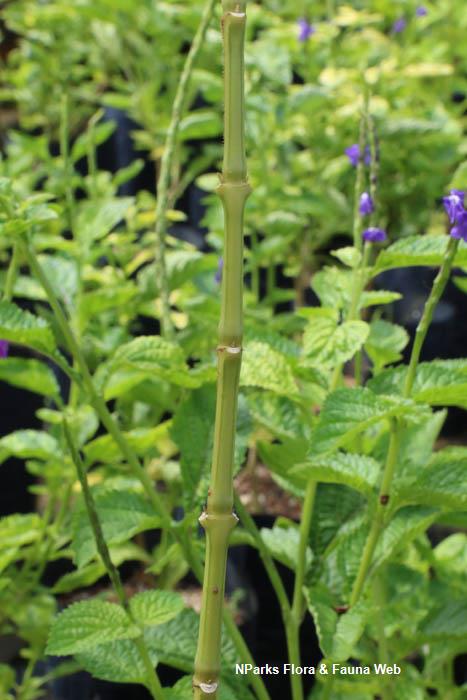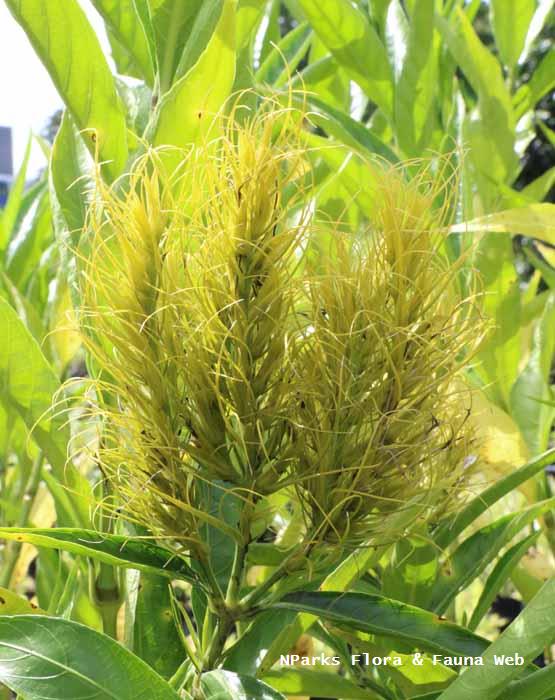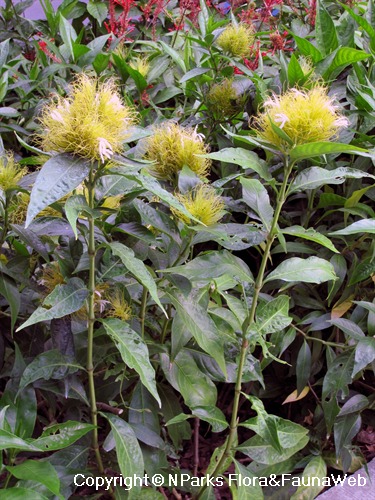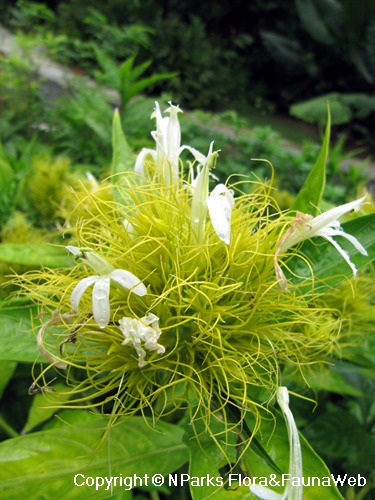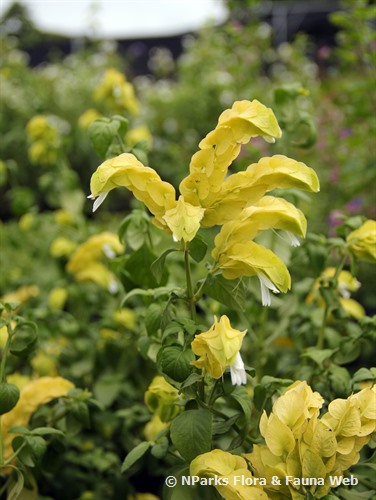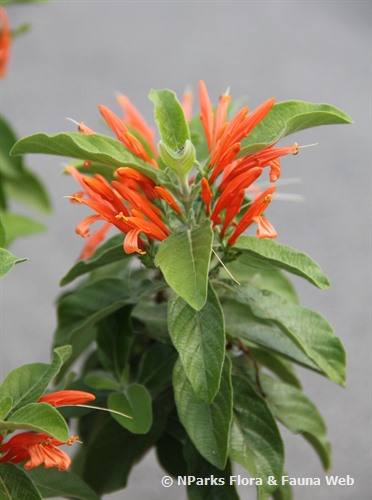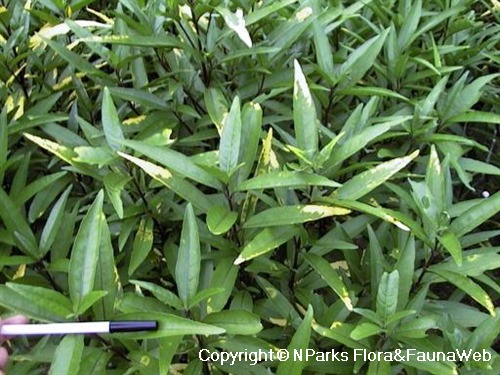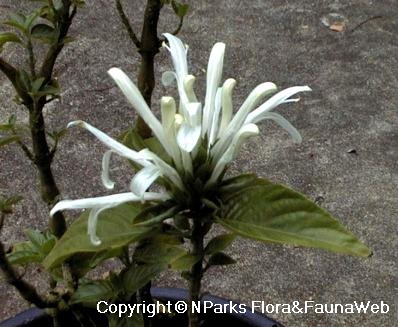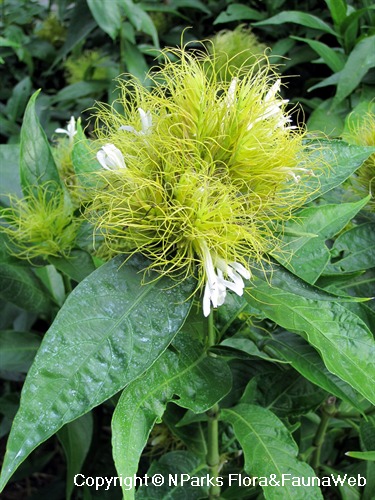
Back
Justicia croceochlamys Leonard
| Family Name: | Acanthaceae |
| Common Name: | Golden Plume, Yellow Jacobinia |
Name
Classifications and Characteristics
| Plant Division | Angiosperms (Flowering Seed Plants) (Dicotyledon) |
|---|---|
| Plant Growth Form | Shrub |
| Lifespan (in Singapore) | Perennial |
| Mode of Nutrition | Autotrophic |
| Plant Shape | Compact |
| Maximum Height | 0.8 m to 1.5 m |
Biogeography
| Native Distribution | Southeastern Brazil |
|---|---|
| Native Habitat | Terrestrial |
| Preferred Climate Zone | Tropical |
| Local Conservation Status | Non-native (Horticultural / Cultivated Only) |
Description and Ethnobotany
| Growth Form | An evergreen shrub that grows from 0.8 m to 1.5 m tall |
|---|---|
| Foliage | Opposite leaves ovate to lanceolate with entire or wavy leaf margin (10 cm long). Pinnate venation is clearly visible. Leaf is petiolate, measuring 8 - 18.5 cm long and 2.7 - 8 cm wide, base cuneate to cordate, rarely rounded; apex acute to attenuate; smooth surface. |
| Crown Shaft | Young stems are nearly square, smooth or slightly hairy. |
| Flowers | Flowers are white and tubular. The inflorescence consists of several flowers surrounded by a dense clump of yellow, hair-like bracts and sepals (10 cm long). A thyrse inflorescence (the youngest flowers being at the top of the inflorescence axis). |
| Fruit | Fruits are known as capsules, measuring 1.2 - 1.5 cm long and contain only a few seeds. They open forcefully with explosive dehiscence. Seeds are attached to hook-like structures inside the fruit which may cause seeds to fly further away from the plant during dehiscence. |
| Habitat | In its native habitat, it is found growing in rainforests, from 150 to 700 m above sea level. |
| Cultivation | Plant this species in fertile, well-drained soil that is kept moist. Feed plants with a high nitrogen fertilizer. When plants become leggy, hard prune them and then fertilze to maintain a compact and bushy growth form. |
Landscaping Features
| Landscaping | This species is planted as an ornamental shrub for its unique and elaborate blooms. The actual, tubular flowers last only a few days, but the yellow hair-like bracts stay fresh for weeks, providing long lasting enjoyment. It is suitable for butterfly gardens as a nectar plant. It would also be appropriate for a "Golden Garden" theme. This species will brighten partly shady areas with its yellow blossoms. |
|---|---|
| Desirable Plant Features | Ornamental Flowers |
| Landscape Uses | Flowerbed / Border |
| Thematic Landscaping | Golden Garden, Butterfly Garden |
Fauna, Pollination and Dispersal
| Fauna Pollination Dispersal Associated Fauna | Butterfly-Attracting |
|---|---|
| Pollination Method(s) | Biotic (Fauna) (Insects (Butterfly, Moth)) |
| Seed or Spore Dispersal | Abiotic (Explosive Dehiscence) |
Plant Care and Propagation
| Light Preference | Full Sun, Semi-Shade |
|---|---|
| Water Preference | Lots of Water, Moderate Water |
| Plant Growth Rate | Moderate |
| Rootzone Tolerance | Easy to Grow, Fertile Loamy Soils, Well-Drained Soils |
| Maintenance Requirements | Low |
| Propagation Method | Stem Cutting |
Foliar
| Foliage Retention | Evergreen |
|---|---|
| Mature Foliage Colour(s) | Green |
| Mature Foliage Texture(s) | Smooth |
| Foliar Type | Simple / Unifoliate |
| Foliar Arrangement Along Stem | Opposite |
| Foliar Attachment to Stem | Petiolate |
| Foliar Shape(s) | Non-Palm Foliage (Ovate, Lanceolate) |
| Foliar Venation | Pinnate / Net |
| Foliar Margin | Entire - Wavy / Undulate |
| Foliar Apex - Tip | Acute |
| Foliar Base | Rounded / Obtuse, Cuneate |
| Typical Foliar Area | Mesophyll ( 45cm2 - 182.25 cm2 ) |
Non - Foliar and Storage
| Stem Type & Modification | Woody |
|---|---|
| Root Type | Underground (Tap Root) |
Floral (Angiosperm)
| Flower & Plant Sexuality | Bisexual Flowers |
| Flower Colour(s) | Yellow / Golden |
|---|---|
| Flower Grouping | Cluster / Inflorescence |
| Flower Location | Terminal |
| Flower Symmetry | Bilateral |
| Individual Flower Shape | Labiate / Lipped |
| Inflorescence Type | Thyrse |
| First-Blooming Flower Bud in Inflorescence | Proximal (Indeterminate Blooming) |
| Flowering Period | Free-Flowering |
| Flower Lifespan on Plant | Several Days |
| Flower Size | 4.5 cm |
Fruit, Seed and Spore
| Fruit Classification | Simple Fruit |
|---|---|
| Fruit Type | Dehiscent Dry Fruit , Capsule |
Image Repository
Others
| Master ID | 29415 |
|---|---|
| Species ID | 3724 |
| Flora Disclaimer | The information in this website has been compiled from reliable sources, such as reference works on medicinal plants. It is not a substitute for medical advice or treatment and NParks does not purport to provide any medical advice. Readers should always consult his/her physician before using or consuming a plant for medicinal purposes. |

